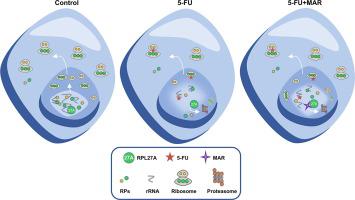Science Bulletin ( IF 18.8 ) Pub Date : 2023-07-15 , DOI: 10.1016/j.scib.2023.07.018 Mengying Hong 1 , Yushen Du 1 , Dongdong Chen 2 , Yuan Shi 3 , Menglong Hu 4 , Kejun Tang 5 , Zhuping Hong 6 , Xiangzhi Meng 7 , Wan Xu 8 , Gaoqi Wu 9 , Yuanyuan Yao 10 , Liubo Chen 5 , Wenteng Chen 11 , Chit Ying Lau 8 , Li Sheng 3 , Tian-Hao Zhang 12 , Haigen Huang 3 , Zheyu Fang 5 , Yong Shen 5 , Fangfang Sun 5 , Jing Qian 6 , Haibin Qu 6 , Shu Zheng 13 , Suzhan Zhang 13 , Kefeng Ding 13 , Ren Sun 14

|
Martynoside (MAR), a bioactive component in several well-known tonic traditional Chinese herbs, exhibits pro-hematopoietic activity during 5-fluorouracil (5-FU) treatment. However, the molecular target and the mechanism of MAR are poorly understood. Here, by adopting the mRNA display with a library of even-distribution (md-LED) method, we systematically examined MAR-protein interactions in vitro and identified the ribosomal protein L27a (RPL27A) as a key cellular target of MAR. Structural and mutational analysis confirmed the specific interaction between MAR and the exon 4,5-encoded region of RPL27A. MAR attenuated 5-FU-induced cytotoxicity in bone marrow nucleated cells, increased RPL27A protein stability, and reduced the ubiquitination of RPL27A at lys92 (K92) and lys94 (K94). Disruption of MAR binding at key residues of RPL27A completely abolished the MAR-induced stabilization. Furthermore, by integrating label-free quantitative ubiquitination proteomics, transcriptomics, and ribosome function assays, we revealed that MAR restored RPL27A protein levels and thus rescued ribosome biogenesis impaired by 5-FU. Specifically, MAR increased mature ribosomal RNA (rRNA) abundance, prevented ribosomal protein degradation, facilitated ribosome assembly, and maintained nucleolar integrity. Collectively, our findings characterize the target of a component of Chinese medicine, reveal the importance of ribosome biogenesis in hematopoiesis, and open up a new direction for improving hematopoiesis by targeting RPL27A.
中文翻译:

Martynoside 通过稳定 RPL27A 来拯救 5-氟尿嘧啶受损的核糖体生物合成
马蒂诺苷 (MAR) 是几种著名的滋补中药中的生物活性成分,在 5-氟尿嘧啶 (5-FU) 治疗过程中表现出促造血活性。然而,MAR 的分子靶点和机制尚不清楚。在这里,通过采用均匀分布文库的mRNA展示(md-LED)方法,我们在体外系统地检测了MAR-蛋白质相互作用,并确定了核糖体蛋白L27a(RPL27A)作为MAR的关键细胞靶标。结构和突变分析证实了 MAR 与RPL27A外显子 4,5 编码区域之间的特异性相互作用。MAR 减弱了 5-FU 诱导的骨髓有核细胞细胞毒性,增加了 RPL27A 蛋白稳定性,并减少了 RPL27A 在 lys92 (K92) 和 lys94 (K94) 处的泛素化。RPL27A 关键残基上 MAR 结合的破坏完全消除了 MAR 诱导的稳定性。此外,通过整合无标记定量泛素化蛋白质组学、转录组学和核糖体功能测定,我们发现 MAR 恢复了 RPL27A 蛋白水平,从而挽救了 5-FU 损害的核糖体生物发生。具体来说,MAR 增加了成熟核糖体 RNA (rRNA) 的丰度,防止核糖体蛋白质降解,促进核糖体组装,并维持核仁完整性。总的来说,我们的研究结果表征了中药成分的靶点,揭示了核糖体生物发生在造血中的重要性,并为靶向RPL27A改善造血开辟了新方向。





















































 京公网安备 11010802027423号
京公网安备 11010802027423号